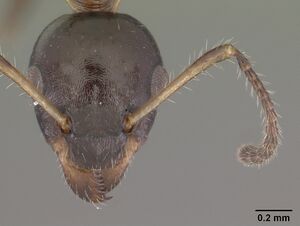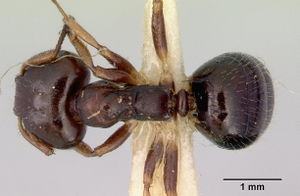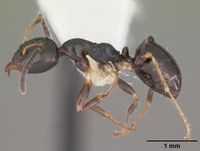Myrmecorhynchus emeryi
| Myrmecorhynchus emeryi | |
|---|---|

| |
| Myrmecorhynchus emeryi | |
| Scientific classification | |
| Kingdom: | Animalia |
| Phylum: | Arthropoda |
| Class: | Insecta |
| Order: | Hymenoptera |
| Family: | Formicidae |
| Subfamily: | Formicinae |
| Tribe: | Melophorini |
| Genus: | Myrmecorhynchus |
| Species: | M. emeryi |
| Binomial name | |
| Myrmecorhynchus emeryi André, 1896 | |
| Synonyms | |
| |
Myrmecorhynchus emeryi is the most widely distributed species in the genus, occurring from south-eastern Queensland (with a single record further north) south through New South Wales and Victoria to south-western Western Australia. It is found in a range of habitats including mallee, sandstone scrub and moist gully woodlands, dry to wet sclerophyll and rainforest. Nests are found in dead branches, twigs and vines, in soil most commonly at the base of tree but also under rocks or occasionally in moss. Nests have also been found in dead stumps (including a Xanthorrhoea stump). Three females were found in a cavity in a small dead twig 2.5m (8 ft) above the ground. This would suggest that this species is pleometrotic, however additional observations are needed to confirm this. Workers are most commonly seen foraging on trees and low vegetation and have been found feeding at extra-floral nectaries of Acacia pycnantha. (Shattuck 2015)
Identification
Shattuck (2015) - Mesosomal dorsum and legs with abundant erect hairs. Body colour variable, ranging from reddish to reddish-brown.
Keys including this Species
- Key to Formicinae genera of the southwestern Australian Botanical Province
- Key to Myrmecorhynchus species
Distribution
Latitudinal Distribution Pattern
Latitudinal Range: -21.14999962° to -38.48332977°.
| North Temperate |
North Subtropical |
Tropical | South Subtropical |
South Temperate |
- Source: AntMaps
Distribution based on Regional Taxon Lists
Australasian Region: Australia (type locality).
Distribution based on AntMaps
Distribution based on AntWeb specimens
Check data from AntWeb
Countries Occupied
| Number of countries occupied by this species based on AntWiki Regional Taxon Lists. In general, fewer countries occupied indicates a narrower range, while more countries indicates a more widespread species. |

|
Estimated Abundance
| Relative abundance based on number of AntMaps records per species (this species within the purple bar). Fewer records (to the left) indicates a less abundant/encountered species while more records (to the right) indicates more abundant/encountered species. |

|
Elevation Range
| Species | Elevation (m asl) | |||||
|---|---|---|---|---|---|---|
| 200 | 400 | 600 | 800 | 1000 | 1200 | |
| Myrmecorhynchus emeryi | 0-10 | 30-40 | 90-100 | 90-100 | ||
| Shading indicates the bands of elevation where species was recorded. Numbers are the percentage of total samples containing this species. | ||||||
Biology
Castes
Worker
Images from AntWeb
   
| |
| Worker. Specimen code casent0010931. Photographer April Nobile, uploaded by California Academy of Sciences. | Owned by UCDC, Davis, CA, USA. |
   
| |
| Worker. Specimen code casent0173619. Photographer April Nobile, uploaded by California Academy of Sciences. | Owned by MCZ, Cambridge, MA, USA. |
   
| |
| Worker. Specimen code casent0178500. Photographer April Nobile, uploaded by California Academy of Sciences. | Owned by MCZ, Cambridge, MA, USA. |
   
| |
| Worker. Specimen code casent0010929. Photographer April Nobile, uploaded by California Academy of Sciences. | Owned by UCDC, Davis, CA, USA. |
   
| |
| Worker. Specimen code casent0172033. Photographer April Nobile, uploaded by California Academy of Sciences. | Owned by ANIC, Canberra, Australia. |
   
| |
| Specimen code CAS0172033-Antwiki.jpg. . | |
   
| |
| . | |
Queen
Images from AntWeb
   
| |
| Queen (alate/dealate). Specimen code casent0172034. Photographer April Nobile, uploaded by California Academy of Sciences. | Owned by ANIC, Canberra, Australia. |
Male
   
| |
| . | |
Nomenclature
The following information is derived from Barry Bolton's Online Catalogue of the Ants of the World.
- emeryi. Myrmecorhynchus emeryi André, 1896b: 254 (w.) AUSTRALIA. Emery, 1898b: 238 (s.); Wheeler, W.M. 1917f: 17 (l.); Wheeler, G.C. & Wheeler, J. 1968: 208 (l.); Clark, 1934b: 41 (q.m.). Senior synonym of musgravei, rufithorax: Shattuck, 2015: 287.
- musgravei. Myrmecorhynchus musgravei Clark, 1934b: 43, pl. 3, fig. 10 (m.) AUSTRALIA. Junior synonym of emeryi: Shattuck, 2015: 287.
- rufithorax. Myrmecorhynchus rufithorax Clark, 1934b: 46,pl. 3, figs. 17, 18 (s.w.) AUSTRALIA. Junior synonym of emeryi: Shattuck, 2015: 287.
Unless otherwise noted the text for the remainder of this section is reported from the publication that includes the original description.
Description
Worker
Queen
Clark (1934) - Length, 6-6.5 mm.
Head yellowish red; mandibles darker; thorax, node, gaster and femora brownish; scapes, coxae, trochanters, and tibia yellow; funiculus and tarsi darker.
Mandibles very finely and densely striate, with large scattered punctures. Clypeus coarsely and irregularly striate. Head finely and densely reticulate. Pronotum and mesonotum more superficially reticulate. Scutellum smooth and shining. Epinotum finely transversely striate-reticulate. Node finely reticulate.
Hair yellow, long and erect, abundant throughout, shorter and oblique on antennae and legs. Pubescence not apparent except on funiculus.
Head as broad as long, broadest behind, sides convex, occipital border straight or feebly convex, angles broadly rounded. Mandibles triangular, dorsum strongly convex, furnished with seven strong teeth behind apex. Clypeus broadly produced in front, anterior border concave in middle, angles rounded. Frontal, area large, transverse. Frontal carinae diverging behind, one-fourth broader in front than long, Scapes not extending to occipital border by fully their thickness; first segment of funiculus as long as the two following together, second to tenth as broad as long, apical as long as two preceding together. Eyes large and convex, placed at middle of sides. Ocelli prominent. Thorax fully one and one-half times longer than broad. Pronotum hardly visible from above. Mesonotum one-third broader than long, strongly convex in front, concave behind, parapsidal furrows sharply impressed. Mesonotum one-fourth broader than long, convex in front and behind. Metanotum shows as a narrow bahd. Epinotum two and one-half times broader than long. In profile pronotum short and vertical. Mesonotum strongly convex from apex to base. Scutellum very slightly higher than mesonotum. Metanotum raised and projecting behind. Epinotum convex, rounded into, and shorter than, declivity. Node three times broader than long, oval, convex above; in profile twice as high as long. almost parallel, dorsum convex. Gaster longer than broad. Legs robust. Wings hyaline, discoidal cell small.
Male
Clark (1934) - Length, 6.5-7 mm.
Head and gaster reddish yellow; mandibles, antennae, thorax and legs yellow.
Mandibles smooth and shining, with scattered shallow punctures. Head finely and densely reticulate, somewhat coarser in front. Pronotum, mesonotum and scutellum superficially reticulate, epinotum irregularly reticulate. Node and gaster smooth and shining.
Hair yellow, short and erect, sparse throughout, oblique on antennae and gaster. Pubescence confined to antennae and legs, very fine and adpressed.
Head slightly broader than long, sides strongly convex, occipital border straight or very feebly convex. Mandibles almost half as long as head, edentate, terminal border concave, twice as long as basal border, the angle strongly produced, sharp. Clypeus feebly convex above, produced in front, broadly convex, strongly indented at middle. Frontal area triangular. Frontal carinae not margined. Base of scapes exposed. Scapes thickened at apex, extending beyond occipital border by one-fourth their length; first segment of funiculus one-fourth longer than second, the others longer than broad, fifth to twelfth thickened to apex, apical pointed, twice as long as broad. Eyes large, very convex, slightly in front of middle of sides, ocelli large and prominent, transparent. Thorax one and three-fourths longer than broad. Pronotum, seen from above, short and crescent-like. Mesonotum one-third broader than long, convex in front, concave behind, parapsidal furrows very strongly impressed. Scutellum broader than long, oval. Epinotum twice as broad as long. In profile pronotum vertical, convex near top. Mesonotum high, strongly convex from apex to base. Scutellum broader than long, oval. Epinotum twice as broad as long. In profile pronotum vertical, convex near top. Mesonotum high, strongly convex from apex to base. Scutellum convex, slightly higher than mesonotum, metanotum not projecting behind. Epinotum flat on top, declivity oblique, feebly convex, longer than dorsum, into which it is rounded. Node twice as broad as long, oval, convex on top; in profile one and three-fourths higher than long, anterior and posterior faces feebly convex, dorsum strongly convex. Gaster one-fourth longer than broad. Genital exserted. Valves slender. Legs long and robust. Wings with a small discoidal cell.
Type Material
- Myrmecorhynchus emeryi: Holotype, worker, Victorian Alps, Victoria, Australia, CASENT0913670, Musee National d'Histoire Naturelle.
- Myrmecorhynchus musgravei: Holotype, male, Lamington Nat. Park (as National Park), Queensland, Australia, 19 December 1926, A. Musgrave, Australian Museum.
- Myrmecorhynchus rufithorax: Syntype, workers, Warburton, Victoria, Australia, Museum Victoria, Melbourne.
References
- André, E. (1896). Fourmis nouvelles d'Asie et d'Australie. Revue d'Entomologie (Caen), 15: 251–265.
- Burwell, C.J., Nakamura, A. 2020. Rainforest ants (Hymenoptera: Formicidae) along an elevational gradient at Eungella in the Clarke Range, Central Queensland coast, Australia. Proceedings of the Royal Society of Queensland 125: 43-63.
- Cantone S. 2017. Winged Ants, The Male, Dichotomous key to genera of winged male ants in the World, Behavioral ecology of mating flight (self-published).
- Cantone S. 2018. Winged Ants, The queen. Dichotomous key to genera of winged female ants in the World. The Wings of Ants: morphological and systematic relationships (self-published).
- Clark, J. 1934b. New Australian ants. Mem. Natl. Mus. Vic. 8: 21-47 (page 41, queen, male described)
- Emery, C. 1898b. Descrizioni di formiche nuove malesi e australiane. Note sinonimiche. Rend. Sess. R. Accad. Sci. Ist. Bologna (n.s.) 2: 231-245 (page 238, soldier described)
- Heterick, B. E. 2009a. A guide to the ants of South-western Australia. Records of the Western Australian Museum, Supplement 76: 1-206. Part 2.
- Heterick, B.E. 2021. A guide to the ants of Western Australia. Part I: Systematics. Records of the Western Australian Museum, Supplement 86, 1-245 (doi:10.18195/issn.0313-122x.86.2021.001-245).
- Heterick, B.E. 2022. A guide to the ants of Western Australia. Part II: Distribution and biology. Records of the Western Australian Museum, supplement 86: 247-510 (doi:10.18195/issn.0313-122x.86.2022.247-510).
- Shattuck, S.O. 2015. A review of the ant genus Myrmecorhynchus (Hymenoptera: Formicidae). Zootaxa, 3955: 283–290.
- Wheeler, G. C.; Wheeler, J. 1968a. The ant larvae of the subfamily Formicinae (Hymenoptera: Formicidae): supplement. Ann. Entomol. Soc. Am. 61: 205-222 (page 208, larva described)
- Wheeler, W. M. 1917f. The Australian ant-genus Myrmecorhynchus (Ern. André) and its position in the subfamily Camponotinae. Trans. R. Soc. S. Aust. 41: 14-19 (page 17, larva described)
References based on Global Ant Biodiversity Informatics
- Clark J. 1934. New Australian ants. Memoirs of the National Museum, Victoria 8: 21-47.
- Emery C. 1898. Descrizioni di formiche nuove malesi e australiane. Note sinonimiche. Rendiconti delle Sessioni della Reale Accademia delle Scienze dell'Istituto di Bologna (n.s.)2: 231-245.
- Heterick B. E. 2009. A guide to the ants of south-western Australia. Records of the Western Australian Museum Supplement 76: 1-206.
- Shattuck S. O. 2015. A review of the ant genus Myrmecorhynchus (Hymenoptera: Formicidae). Zootaxa 3955(2): 283-290.
- Wheeler W. M. 1917. The Australian ant-genus Myrmecorhynchus (Ern. André) and its position in the subfamily Camponotinae. Transactions of the Royal Society of South Australia 41: 14-19.


